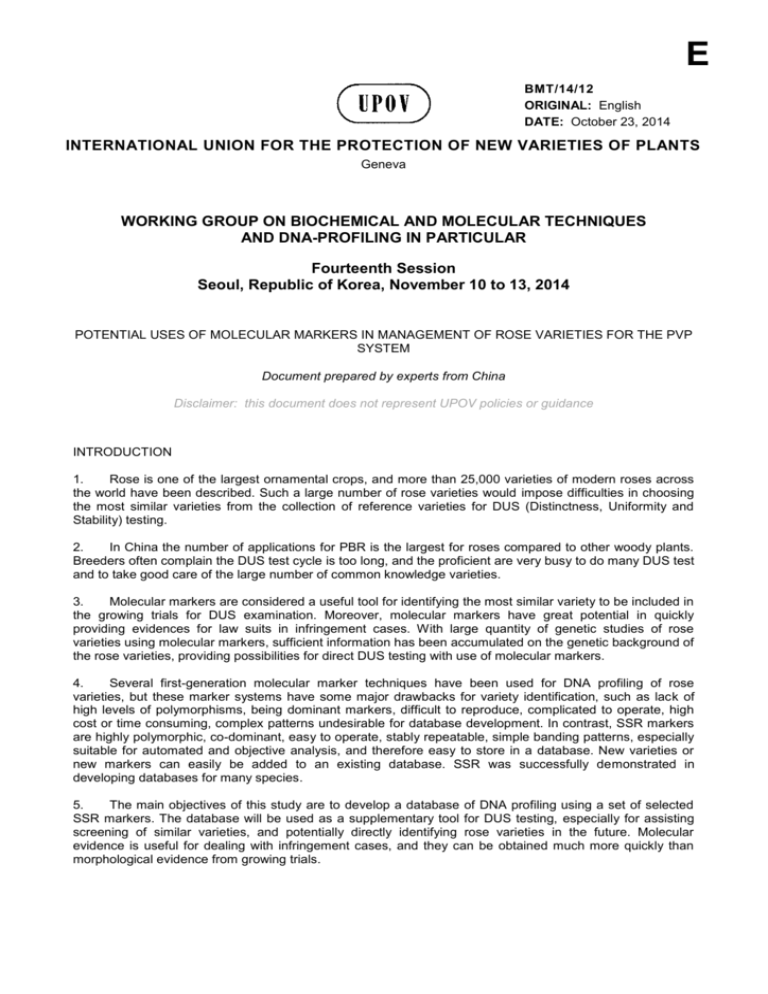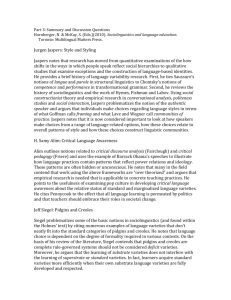Introduction
advertisement

E BMT/14/12 ORIGINAL: English DATE: October 23, 2014 INTERNATIONAL UNION FOR THE PROTECTION OF NEW VARIETIES OF PLANTS Geneva WORKING GROUP ON BIOCHEMICAL AND MOLECULAR TECHNIQUES AND DNA-PROFILING IN PARTICULAR Fourteenth Session Seoul, Republic of Korea, November 10 to 13, 2014 POTENTIAL USES OF MOLECULAR MARKERS IN MANAGEMENT OF ROSE VARIETIES FOR THE PVP SYSTEM Document prepared by experts from China Disclaimer: this document does not represent UPOV policies or guidance INTRODUCTION 1. Rose is one of the largest ornamental crops, and more than 25,000 varieties of modern roses across the world have been described. Such a large number of rose varieties would impose difficulties in choosing the most similar varieties from the collection of reference varieties for DUS (Distinctness, Uniformity and Stability) testing. 2. In China the number of applications for PBR is the largest for roses compared to other woody plants. Breeders often complain the DUS test cycle is too long, and the proficient are very busy to do many DUS test and to take good care of the large number of common knowledge varieties. 3. Molecular markers are considered a useful tool for identifying the most similar variety to be included in the growing trials for DUS examination. Moreover, molecular markers have great potential in quickly providing evidences for law suits in infringement cases. With large quantity of genetic studies of rose varieties using molecular markers, sufficient information has been accumulated on the genetic background of the rose varieties, providing possibilities for direct DUS testing with use of molecular markers. 4. Several first-generation molecular marker techniques have been used for DNA profiling of rose varieties, but these marker systems have some major drawbacks for variety identification, such as lack of high levels of polymorphisms, being dominant markers, difficult to reproduce, complicated to operate, high cost or time consuming, complex patterns undesirable for database development. In contrast, SSR markers are highly polymorphic, co-dominant, easy to operate, stably repeatable, simple banding patterns, especially suitable for automated and objective analysis, and therefore easy to store in a database. New varieties or new markers can easily be added to an existing database. SSR was successfully demonstrated in developing databases for many species. 5. The main objectives of this study are to develop a database of DNA profiling using a set of selected SSR markers. The database will be used as a supplementary tool for DUS testing, especially for assisting screening of similar varieties, and potentially directly identifying rose varieties in the future. Molecular evidence is useful for dealing with infringement cases, and they can be obtained much more quickly than morphological evidence from growing trials. BMT/14/12 page 2 MATERIAL AND METHODS Plant materials 6. In 2012, a total of 152 rose (common knowledge) varieties were sampled, of which 104 varieties from Beijing Botanical Garden and 48 varieties from Rose Test Station in Kunming. From 2013 to 2014, about 700 rose (common knowledge) varieties were sampled from the Rose Test Station. The samples were composed of variety types of ‘China’, ‘Climber’, ‘Floribunda’, ‘Hybrid Tea’, ‘Miniature’, ‘Polyantha’ and ‘Shrub’. 7. Theoretically all plants of a rose variety are the same genotype, therefore only 1 sample plant was randomly selected from each variety, and the second and third leaves from the top of sample plants were collected and exsiccated with silica gel and stored at -80℃ after complete desiccation. DNA profiling 8. DNA was isolated from the dry frozen leaf tissue using the DNA secure Plant Kit (TianGen, CN) following the manufacturer’s instructions. DNA quality was tested via electrophoresis on 1.2% (percent) agarose gel in 1× (times) TAE buffer and observed under UV light, the main band should be uniform, clear and no-tail. Quantitative determination via UV-Vis Spectrophotometer (Nanodrop8000 Thermo Fisher, US), the ratio of DNA intermixture of A260 toA280 should be approximately 1.8. 9. Information on SSR primer pairs was collected from published research papers and public databases, or developed through enrichment, sequencing and other methods if no information is available on primers. 8 DNA samples were randomly selected as templates to optimize the conditions of PCR and test the polymorphism of the amplified successful primers. Polymorphic primers were identified and used for the analysis of all samples. PCR products were tested by fluorescence capillary electrophoresis, using the automatic genetic analysis system (CEQ 8000, Beckmen). DNA fingerprint data was manipulated with Excel software. Data analyses 10. According to the observed presence and sizes of the amplified fragments, a 2-way matrix was established and the number of alleles and the number of allelic phenotypes were recorded for each of the SSR loci. The ability of detecting a variety (D) at a locus was calculated with the formula: I I i 1 i 1 D i 1 Ci 1 ci 1 pi 11. Where locus i. 12. ( NPi 1) N 1 D i is the ability of detecting a variety at locus i, C i is the extent of confusion of genotypes at Pi is the frequency of allelic genotypes at locus I, and N is the size of total samples. The polymorphic information content (PIC) were calculated with PIC 1 - pi , where pi is the 2 allelic frequency at locus i. 13. The effective number of alleles (Ne) was expressed as N e 1/ pi , where pi is the allele 2 2 frequencies of locus i. Database construction 14. The results of DNA fingerprints were recorded in an Excel file arranged in a form of two-way table, respectively varieties in rows and loci in columns as presented in the simplified form (Table 1) Testing the distinctness and screening of similar varieties Search for similar varieties for DUS testing 15. It is easy to find whether the variety under test exists in the database by a typical search function of the Excel. BMT/14/12 page 3 Hybrid and ploidity detection 16. Detection of hybrid varieties and ploidity of a variety can be done by an analysis of the number of alleles at each locus. Genetic similarity (S) 17. The formula used to calculate the genetic similarity between two varieties was: S=1-b/a, where S is the genetic similarity, a is the average number of bands and b is the number of different bands. The greater the value of S, the closer the genetic relationship. Number of Different Loci (DL) 18. DL was used to denote the number of different loci. The larger the value of DL, the greater the differences between the two varieties. If DL≤2, the two varieties were the same variety or essentially derived variety (EDV). If DL>2, the two varieties are considered distinct from each other. The variety under test were compared with all varieties of the database to selected the most similar variety to the candidate variety. BMT/14/12 page 4 RESULTS AND DISCUSSION Selection of core primer pairs 19. A total of 130 microsatellite markers were selected from public papers, 8 DNA samples were randomly chosen as templates of pre-PCR, after tests with varying the annealing temperatures, 41 primer pairs were successful in amplifying rose DNA, 40 loci showed polymorphism and were used in this study (Table 1). Table1: Information of the SSR markers selected for genetic analysis of Rosa varieties No. 1 2 3 4 5 6 7 8 9 10 11 12 13 14 15 16 17 18 19 20 21 22 23 24 25 26 27 28 29 30 31 32 33 34 35 36 37 38 39 40 No.allelic No. unique allelic phenotype phenotype 86 91 92 81 80 71 69 42 76 60 55 46 41 45 52 50 44 33 45 35 32 22 36 43 32 41 20 32 25 16 37 21 12 39 17 24 15 22 10 18 52 59 67 52 45 44 41 19 48 33 25 20 17 21 26 27 24 12 24 16 15 7 18 26 16 25 5 20 10 2 21 7 2 25 7 13 2 9 2 6 No. allele 15 17 16 17 14 19 17 9 18 14 9 10 10 19 11 14 12 8 12 14 11 8 11 13 8 14 6 11 8 5 16 8 4 18 7 9 6 7 5 8 Ne Dj 8.286 7.387 7.192 7.03 7.513 6.673 6.745 5.357 6.797 6.356 6.496 5.3 5.121 5.513 5.395 5.028 4.851 4.374 4.886 4.356 4.379 4.004 4.999 3.997 4.132 4.001 3.623 3.561 3.634 3.702 4.267 3.254 3.401 3.399 3.164 3.09 2.886 3.588 1.551 2.745 0.988 0.988 0.986 0.985 0.984 0.977 0.975 0.975 0.973 0.963 0.958 0.957 0.956 0.954 0.949 0.945 0.942 0.933 0.932 0.927 0.918 0.914 0.912 0.905 0.893 0.889 0.885 0.873 0.871 0.87 0.864 0.831 0.826 0.821 0.808 0.805 0.772 0.771 0.746 0.677 PIC 0.879 0.864 0.86 0.857 0.866 0.85 0.851 0.813 0.852 0.842 0.846 0.811 0.804 0.818 0.814 0.808 0.793 0.771 0.795 0.77 0.77 0.75 0.799 0.749 0.763 0.75 0.724 0.719 0.724 0.729 0.765 0.692 0.706 0.705 0.684 0.676 0.653 0.721 0.644 0.635 BMT/14/12 page 5 Function of the database 20. The results indicated that the divergence of DNA profiling among hybrid varieties was obvious. It is obvious that all varieties are hybrid and tetraploid according information revealed by the 40 loci (the data were too large to be shown here). Screening of similar varieties and variety identification Table 2, Parts of DNA fingerprinting of 4 varieties Locus 1 Locus 2 Locus 3 Locus 4 Variety 1 2 3 4 A1 A2 A3 182 197 203 182 203 182 189 197 182 189 201 A4 201 A1 A2 235 A3 A4 A1 A2 A3 241 248 253 235 241 248 253 241 247 256 238 241 247 256 238 A4 A1 A2 A3 276 289 298 301 276 289 298 301 276 287 289 291 276 287 289 291 A4 301 … … … … … … … … … … … … …… 21. It is clear that variety 1 and variety 2 were most similar to each other (S=0.94), and they may the same one or EDV (DL=1); Variety 3 and variety 4 were most similar to each other (S=0.88), and they may the same one or EDV (DL=2). Variety 1 and variety 3 were not similar to each other (S=0.31), and they were different varieties (DL=4). 22. But in fact, when the loci were add to 40 and the number of varieties were add to 152 or more, it is difficult to count the value of S and DL of every two varieties and compare them by manual, so in the future, it is imperative to develop functional model of automatic statistics. Otherwise, it is necessary to confirm standard varieties and standard DNA to check the size of band to make the data as stable and credible as possible. 23. Continue study to develop more powerful markers which should be more polymorphic and stable, Use the least markers to identify the most varieties to save time and cost. Standardizing for construction of Plants Varieties DNA Fingerprinting Database, which could make the labs all over the world share the results of every research. Zheng Yongqi, Yu Xuedan and Huang Ping Lab for Molecular Identification of Plant Varieties, Office of PVP, State Forestry Administration, Beijing 100091, China REFERENCES 1) 2) H. J. Yan, H. Zhang, J. R. Xie, et al. Development of new SSR markers from EST of SSH cDNA libraries on rose fragrance. Hereditas (Beijing), 2009, 31(9): 962-966. H Nybom, GD Esselink, G Werlemark, et al. Microsatellite DNA marker inheritance indicates preferential pairing between two highly homologous genomes in polyploid and hemisexual dog-roses, Rosa L. Sect. Caninae DC. Heredity, 2004, 92: 139-150. BMT/14/12 page 6 3) 4) 5) 6) 7) 8) L. Hibrand-Saint Oyant, L. Crespel, S. Rajapakse, et al. Genetic linkage maps of rose constructed with new microsatellite markers and locating QTL controlling flowering traits. Tree Genetics and Genomes, 2008, 4(1): 11-23. L. Zhang, D. Byrne, R. Ballard, et al. Microsatellite marker development in rose and its application in tetraploid mapping. Journal of the American Society for Horticultural Science, 2006, 131(3): 380-387. P. Huang, P. J. Cui, Y. Q. Zheng, et al. SSR-Based molecular identification and analysis of genetic relationships among rose varieties. Scientia Silvae Sinicae, 2012, 48(10): 55-62. T. Kimura, C. Nishitani, H. Iketani, et al. Development of microsatellite markers in rose. Molecular Ecology Notes, 2006, 6(3): 810-812. Y. H. Park, , S. G. Ahn, Y. M. Choi, et al. Rose (Rosa hybrida L.) EST-derived microsatellite markers and their transferability to strawberry (Fragaria spp.). Scientia Horticulturae. 2010, 125(4): 733-739. Z. Yan, C. Denneboom, A. Hattendorf, et al. Construction of an integrated map of rose with AFLP, SSR, PK, RGA, RFLP, SCAR and morphological markers. Theoretical and Applied Genetics. 2005, 110(4): 766-777. [End of document]





